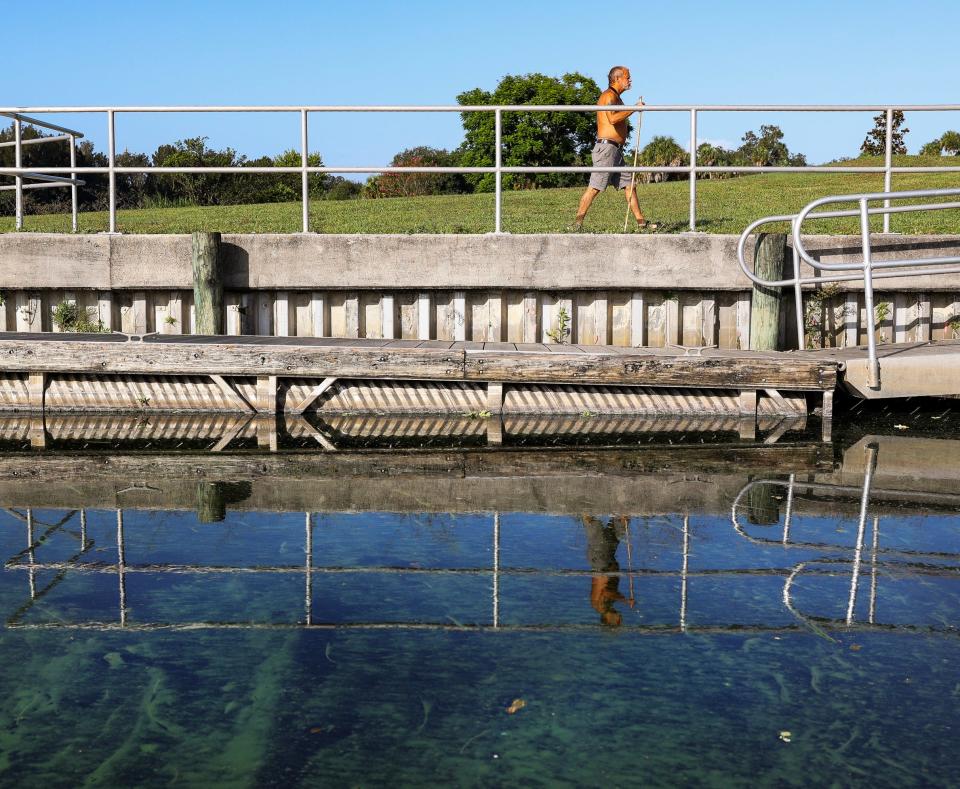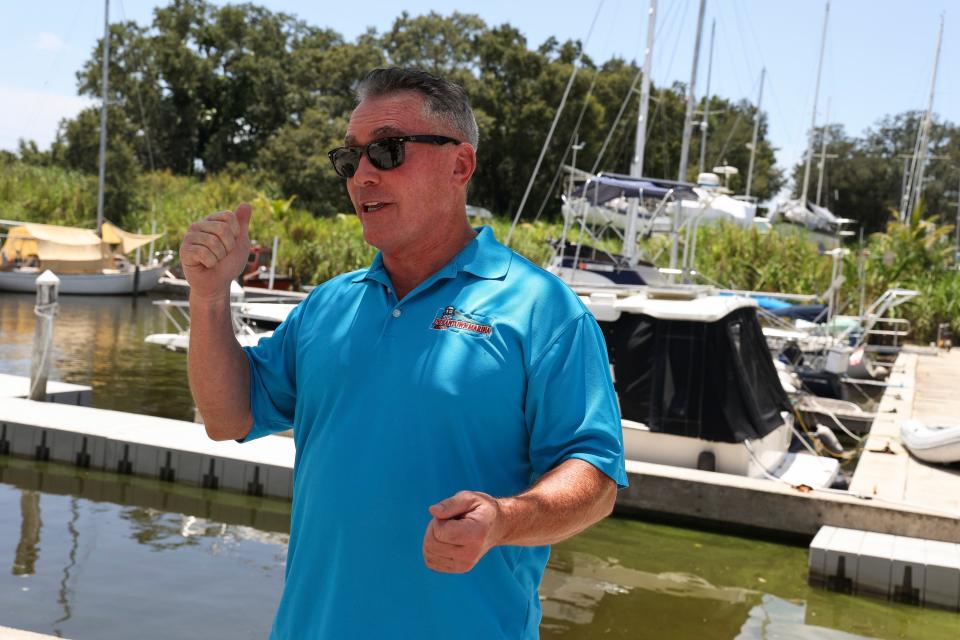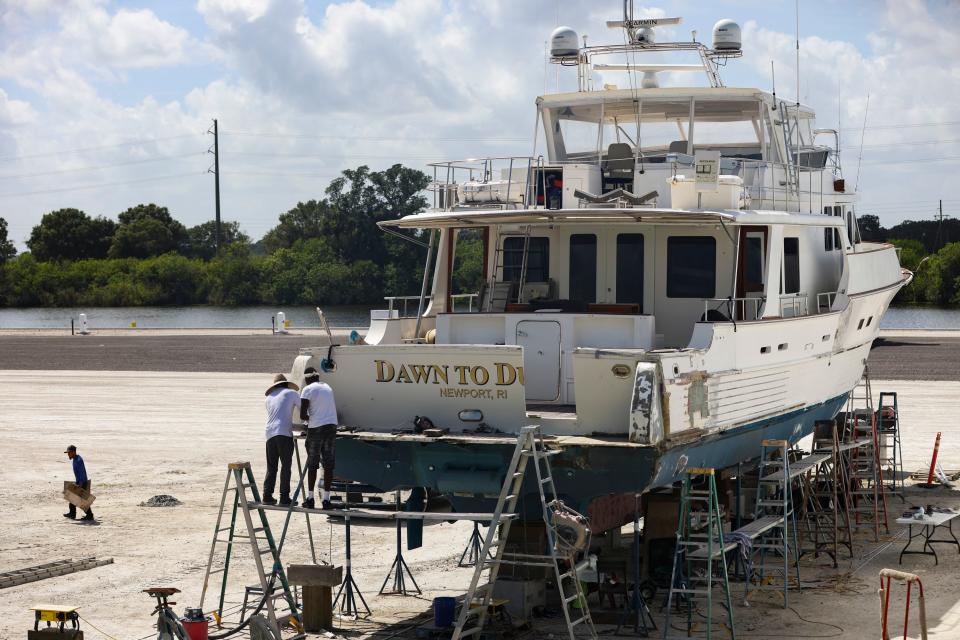Indiantown suffers toxic algae bloom from Lake Okeechobee discharges to C-44 Canal
Guacamole-green splotches coat the Indiantown Marina like skim on milk, swirling around a live-aboard and his Hunter 37-foot sailboat that's being repaired. In the six months that Mike LeCompte has been moored at the dock, he has developed a cough. His boat has no filtration from the toxic algae surrounding him.
A bloom 100 times worse than the Environmental Protection Agency considers safe for people and pets was confirmed at Timer Powers Park Aug. 3 — five days before the health department alerted the public.
The Army Corps of Engineers had released Lake Okeechobee water into the C-44 Canal that runs past Indiantown — and the toxic algae could pollute the St. Lucie River in Stuart if the agency opens the St. Lucie Lock & Dam.
“All the wildlife seems to be disappearing, and I'm sure it's just poisoning everything,” LeCompte said. “When my boat is finished, I’ll be leaving here. I don’t think I’ll come back.”

Indiantown residents suffer toxic algae
Most Indiantown residents can’t escape to cleaner air or water. Among the 6,633 residents, nearly 20% live below the poverty level and $44,234 is the average annual income, below the $61,777 state level, according to 2021 Census Bureau data. Residents are 63% Hispanic, 18% Black and 17% white, and over 24% are foreign-born.
In the St. Lucie Mobile Village, fishing poles line up outside mobile homes, as many families fish for their dinner — or they used to. Tenant Nereida Aguirre said community leaders aren't doing enough to stop water pollution.
“Honestly, I feel like I really can't do anything because even if we go to the council in Indiantown, they don't really seem to understand,” she said, standing 200 feet from the C-44 Canal. “A lot of people in Indiantown don't seem to understand that there's a lot of climate change. The water is changing around here.”
She no longer sees manatees and alligators, but she sees plenty of dead fish floating, including bass, whenever the algae thickens. That's at least once a year, she said.
“There's always bad algae, and if there isn't, it's always fish dying,” she said.
She also gets sick for days after being in the water, and suspects it's from the toxic algae.
“I don't really know because I don't go to the hospital that much, but I usually stay in bed, and I just felt really low," she said, describing a recent episode. "I couldn't get up, and if I did, I felt so dizzy and nauseous.”
She no longer fishes in the canal from her 10-foot orange kayak. She doesn’t trust the water, she said. Several of her neighbors also have stopped reeling in bass and tilapia, partially because of the toxic algae.
A few months ago, Iralda and Estrella Meija were eating about 10 mojarras a week they caught at Timer Powers Park, about five miles away. They recently gathered with two neighboring families for a meal of seared freshwater fish with rice and black beans, salad and guacamole. But they stopped eating the fish when they started finding parasitic worms in the fishes' chins and cheeks.
“We don’t fish or swim there because the water is dirty and scary,” said 11-year-old Estrella Meija.
Toxic algae poses health risks
Not everyone believes toxic algae is a health threat, despite many studies and hospital reports showing otherwise. Short-term effects include runny nose, watery eyes and trouble breathing. Long-term effects include liver and neurological diseases such as Parkinson's, Alzheimer's and amyotrophic lateral sclerosis (ALS or Lou Gehrig's).
Emergency rooms reported an increase in people complaining of nausea, vomiting, skin rashes, coughing, shortness of breath and achy limbs and joints during the massive blooms in 2016 and 2018. And a Stuart vet suspects the algae killed one dog and sickened at least five others in 2018.

Still, Scott Watson, who has owned Indiantown Marina for 21 years, called toxic algae a “political football.” He compared exposure to drinking too much water, and said he doesn't take any precautions against it.
“It can be somewhat unsightly,” he said. “But as far as the overall health concerns and all this other stuff that you hear a lot of hype about, we have never experienced that.”
Decaying algae smells putrid from all the ammonia and hydrogen sulfide that stinks like rotten eggs.
Business hasn't slowed at the Indiantown Marine Center, but President Dan Romence said one precaution he takes is not letting employees work in the water. Worker Edwin Avelar said if the algae worsens, he plans to wear a mask.

At least the toxic algae hasn't polluted the agricultural fields, said Seminole Inn Vice President Jonnie Flewelling, who raises cattle along Kanner Highway. The cattle drink from puddles that drift from the canal, but they wouldn’t drink poisoned water, she said.
At Timer Powers Park Wednesday, a handful of runners and hikers circled the water but remained on the dock a few feet from the algae — two days after the health department posted warning signs in English and Spanish.
Wildlife has dwindled and a hawk pair has disappeared, said Rogelio Delcampo, a former Caulkins citrus farm manager who feeds peanuts to birds and squirrels at the park three times a week.
“I can’t do nothing about it. I just stay away from it,” he said, adding he wouldn’t swim in the water. “Either a gator would get you or the algae.”
Katie Delk is TCPalm's environment reporter. Contact her at katie.delk@tcpalm.com or 772-408-5301. Check for updates @katie_delk.
This article originally appeared on Treasure Coast Newspapers: Indiantown suffers toxic algae bloom from Lake Okeechobee discharges

